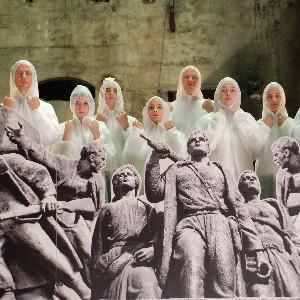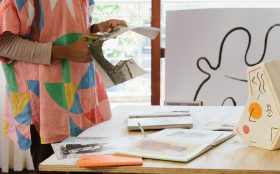This autumn the ICA is presenting, or should I say hosting, Chto delat?, the Russian collective composed of artists, writers, philosophers and activists who, through political coordination, aim to merge politics, art, theory and activism to create a platform for their leftist principles. The group has been active in Russia since 2003, their ideas rooted in observations of post-perestroika Russia, the aftermath of economic restructuring of the Soviet State initiated by Mikhail Gorbachev.
The exhibition at the ICA marks the collective’s first solo show in the United Kingdom. On entering I was immediately aware that this is something very different from the ICA’s past oeuvre, and thus instantly exciting. With the help of the ICA, the collective was allowed to infiltrate the problematic exhibition space, set free to explore their leftist position on economic, social, and cultural agendas through creating a series of displays modelled on Russian Constructivist Alexander Rodchenko’s design for the interior of a workers’ club.
On walking in, one is bombarded with imagery, words and colour, newspapers (the collective’s published work – also available as handouts) line the base of the wall, and drawings are scattered across the white gallery wall where a woman with a fox’s head asks ‘Do you mind if I perform a history dance?” (Later I discover this is a reference to the ‘Wolf-Girls’, mythical advisers to Gorbachev). What seems at first like scattered references to Russian political history, with Soviet heroes such as Alexey Stakhanov and leftist icons such as Jean-Luc Godard adorning the walls, actually becomes a more cohesive vision as the exhibition unfolds.
A principal feature of the exhibition is a constructed three-tier cinema where visitors can sit in comfort, on pillows printed with the collective’s publications, and watch the narrative film Tower Songspiel (2010), the final part in a trilogy of socially engaged musicals – the centre of the visual practice of Chto delat? The film is based on real documents and events that emerged over the controversial Gazprom corporation’s proposal to build a 403-meter-high skyscraper dominating the St Petersburg skyline.
A group of suits sit round a table with an ominous over-sized buttonless black phone in the centre, discussing how to convince the people of the tower and exclaiming that “The city will be the Dubai of the north”.
I was instantly struck by the successful use of the Verfremdungseffekt (distancing effect) that Bertold Brecht, their direct influence, used within his plays to turn the viewer into a consciously critical observer. In a sense, this work almost is an ‘idiot’s guide to Russia’, but the simplicity of defining the relationship between authority and the populace is necessary to have the desired educational impact. The collective is firmly rooted in the educational value of art, and the exhibition is based on activities that achieve this – watching the films, reading the publications, listening to the audio guide created by the artists, and online debates and public discussion.
The exhibition’s dynamism comes from the very thing that defines the collective’s stance, its active involvement in participation and activism. While this is a hard challenge to express in a static exhibition, restricted by time and space, the collective and the ICA have overcome this by having members of the collective present in London for the duration and turning the ICA into a platform for discourse. During Dissent, a season of talks, screenings, performances, including ‘48 Hour Communal Life Seminar: What Struggles Do We Have In Common?’ each week they pose a different question; this week is ‘Is Society Broken?’. These programmes must not be read as an afterthought to the exhibition, rather the exhibition must be viewed as a platform for these programmes, as it is from these actions, discussions and communications that the exhibition springs forth and is made complete.
Of course while the ICA acts as a venue for a platform of discussion, and has provided the collective with autonomy when creating the show, one cannot avoid the paradoxical conflict in the collective’s collaboration with the ICA. Throughout their work they question and offer a critique of contemporary art and its institutions, they understand the value of art lying in education and activism, not a commodity or entertainment, and as stated in their newspaper, “In the contemporary conjuncture, the self negation essential to art’s development happens outside institutional practices”. This ongoing debate about the Institution’s involvement in contemporary practice, and those artists who choose and do not choose to bend to the will of the authority, is a direct question Chto delat? raise in their work which fails to be answered at the ICA. One can only presume, and hope, this will be key to the discussions over the coming months.
The project at the ICA is realised by: Tsaplya (Olga Egorova), Nikolay Oleynikov, Gluklya (Natalya Pershina-Yakimanskaya), Nina Gasteva, Vladan Jeremic/Rena Rädle and Dmitry Vilensky.
Chto delat? (What is to be done?) : The Urgent Need to Struggle
Institute of Contemporary Art
12 Carlton House Terrace
London SW1Y 5AH
020 7930 3647
Season: 9 September 2010 – 24 October 2010
The exhibition is free, but many of the events are ticketed, for more details visit http://www.ica.org.uk/





